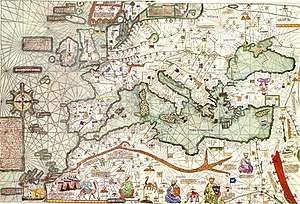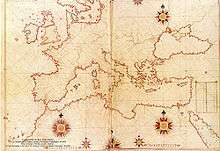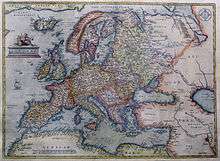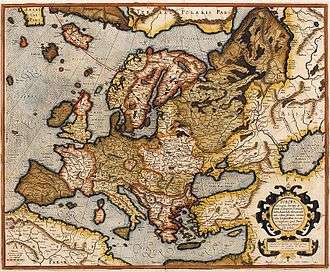Brasil (mythical island)
| Native name: Hy-Brasil, Hy Brasil, Hy Breasil, Hy Breasail, Hy Breasal, Hy Brazil, I-Brasil | |
|---|---|
 Brasil as shown in relation to Ireland on a map by Abraham Ortelius (1572) | |
| Etymology | Uí Breasail: in honour of the descendants of Bresail[1] |
| Geography | |
| Location | Mythical, Atlantic Ocean |
Brasil, also known as Hy-Brasil or several other variants,[2] is a phantom island said to lie in the Atlantic Ocean[3] west of Ireland. Irish myths described it as cloaked in mist except for one day every seven years, when it becomes visible but still cannot be reached.
Etymology
The etymology of the names Brasil and Hy-Brasil is unknown, but in Irish tradition it is thought to come from the Irish Uí Breasail (meaning "descendants (i.e., clan) of Bresail"), one of the ancient clans of northeastern Ireland. cf. Old Irish: Í: island; bres: beauty, worth, great, mighty.[1]
Despite the similarity, the name of the country Brazil, also spelled Brasil, has no connection to the mythical islands. The South American country was at first named Ilha de Vera Cruz (Island of the True Cross) and later Terra de Santa Cruz (Land of the Holy Cross) by the Portuguese navigators who arrived there. After some decades, it started to be called "Brazil" (Brasil, in Portuguese) due to the exploitation of native brazilwood, at that time the only export of the land. In Portuguese, brazilwood is called pau-brasil, with the word brasil commonly given the etymology "red like an ember", formed from Latin brasa ("ember") and the suffix -il (from -iculum or -ilium).[4][5][6]
Appearance on maps
Nautical charts identified an island called "Bracile" west of Ireland in the Atlantic Ocean as far back as 1325, in a portolan chart by Angelino Dulcert. Later it appeared as Insula de Brasil in the Venetian map of Andrea Bianco (1436), attached to one of the larger islands of a group of islands in the Atlantic. This was identified for a time with the modern island of Terceira in the Azores.
A Catalan chart of about 1480 labels two islands "Illa de brasil", one to the south west of Ireland (where the mythical place was supposed to be) and one south of "Illa verde" or Greenland.
On maps the island was shown as being circular, often with a central strait or river running east-west across its diameter. Despite the failure of attempts to find it, this appeared regularly on maps lying south west of Galway Bay until 1865, by which time it was called Brasil Rock.
Map gallery
 Catalan atlas from 1375
Catalan atlas from 1375 Piri Reis' map of Europe and the Mediterranean Sea from 1513
Piri Reis' map of Europe and the Mediterranean Sea from 1513 Map of Europe from 1570
Map of Europe from 1570 Abraham Ortelius' map of Europe from 1595
Abraham Ortelius' map of Europe from 1595 Gerardus Mercator's map from 1595
Gerardus Mercator's map from 1595
Searches for the island
Expeditions left Bristol in 1480 and 1481 to search for the island; and a letter written by Pedro de Ayala, shortly after the return of John Cabot (from his expedition in 1497), reports that land found by Cabot had been "discovered in the past by the men from Bristol who found Brasil".[7]
In 1674 a Captain John Nisbet claimed to have seen the island when on a journey from France to Ireland, stating that the island was inhabited by large black rabbits and a magician who lived alone in a stone castle, yet the character and the story were a literary invention by Irish author Richard Head.[8] Roderick O'Flaherty in A Chorographical Description of West or H-Iar Connaught (1684) tells us "There is now living, Morogh O'Ley (Murrough Ó Laoí), who imagines he was personally on O'Brasil for two days, and saw out of it the iles of Aran, Golamhead [by Lettermullen], Irrosbeghill, and other places of the west continent he was acquainted with."
Hy-Brasil has also been identified with Porcupine Bank, a shoal in the Atlantic Ocean about 200 kilometres (120 mi) west of Ireland[9] and discovered in 1862. As early as 1870 a paper was read to the Geological Society of Ireland suggesting this identification.[10] The suggestion has since appeared more than once, e.g., in an 1883 edition of Notes and Queries[11] and in various twentieth-century publications, one of the more recent being Graham Hancock's book Underworld: The Mysterious Origins of Civilization.
In popular culture
- Frederick Delius wrote a song titled I-Brasil (c. 1913) with words attributed to Fiona McLeod, pseudonym of the Celtic revival writer William Sharp.[12]
- Hy-Brasil was featured in the 1989 British comedy-fantasy film Erik the Viking starring Tim Robbins.
- Peter Bishop mysteriously travels to Hy-Brasil in the Beyond the Fringe comic book, a tie-in for the Fringe television series.
- In the PC Massively multiplayer online role-playing game Dark Age of Camelot, Hybrasil was expansion content for the Hibernia faction in the first expansion pack, Shrouded Isles, which depicted it as being occupied by attacking Fomorians.
- The island of Hybras is the setting of Lyonesse trilogy by Jack Vance, and was geographically located in the Sea of Biscay, west of France and north of Spain, but it sank into the sea, in a parallel to Atlantis.
- "Hy-Brasil" is featured on signs affixed on the façade of the Embassy of Brazil to Bridgetown, Barbados, something which may reference when Barbados was claimed but later abandoned by the Portuguese.
- A land called Hy Brasil features in Alan Moore's comic Promethea.
- J. R. R. Tolkien mentions the isle of "Breazail" in one of his Corrigan poems contained in the book 'The Lay of Aotrou & Itroun'.
- Margaret Elphinstone's 2002 novel Hy Brasil is set on the mythical island.
- In Mary Stewart's 1973 novel The Hollow Hills, second of a five-part Arthurian saga, it is rumored between the commonfolk that Merlin hid the infant Arthur in the island of "Hy-Brasil".
- Mary Burke's short story "Hy-Brasil" in The Faber Book of Best New Irish Short Stories, 2004–5.[13][14]
See also
- Irish mythology in popular culture
- Inisheer
- Tech Duinn a mythological island to the west of Ireland where souls go after death.
- Great Ireland a similarly west-of-Ireland place, Irish myths of which, are believed to have influenced the Vikings.
References
- 1 2 McKillop, James (1998). "Hy Brasil". A Dictionary of Celtic Mythology. Oxford University Press.
- ↑ Hy Brasil, Hy Breasil, Hy Breasail, Hy Breasal, Hy Brazil, I-Brasil
- ↑

- ↑ CNRTL – Centre National de Ressources Textuelles et Lexicales (in French)
- ↑ Michaelis – Moderno Dicionário da Língua Portuguesa (in Portuguese)
- ↑ iDicionário Aulete Archived 29 February 2012 at the Wayback Machine. (in Portuguese)
- ↑ Seaver, K.A. (1995) The Frozen Echo, Stanford University Press, p. 212 ISBN 0-8047-3161-6
- ↑ Barbara Freitag – Hy Brasil: The Metamorphosis of an Island, Rodopi, 2013
- ↑ Velasco, Francisco; Jorge Landa; Joaquín Barrado; Marian Blanco (2008). "Distribution, abundance, and growth of anglerfish (Lophius piscatorius) on the Porcupine Bank (west of Ireland)". ICES Journal of Marine Science. 65 (7): 1316. doi:10.1093/icesjms/fsn130. Retrieved 18 November 2010.
- ↑ Winsor, Justin (1889). Narrative and critical history of America (Volume 01). Houghton, Mifflin and Company. p. 51.
- ↑ Frazer, W. (December 1883), "O'Brazile or Hy Brazile", Notes and Queries, s6-VIII: 475
- ↑ The score, published 1915, has a note in German, mentioning I-Brasil as a legendary Irish island.
- ↑ "'Hy-Brasil,' The Faber Book of Best New Irish Short Stories, 2004–5, Faber & Faber, 2005, pp. 101–05". www.academia.edu. Retrieved 23 March 2016.
- ↑ Marcus, David, ed. (2005), The Faber Book of Best New Irish Short Stories 2004–05, Faber, ISBN 978-0571224197
Further reading
- Freitag, Barbara (2013). Hy Brasil: the metamorphosis of an island: from cartographic error to Celtic Elysium. Amsterdam: Rodopi. ISBN 9789042036413.
- Sean Lynch (2010). "Preliminary Sketches for the Reappearance of HyBrazil". Utopian Studies. 21 (1): 5–15. doi:10.1353/utp.0.0003.